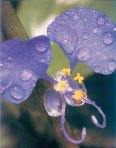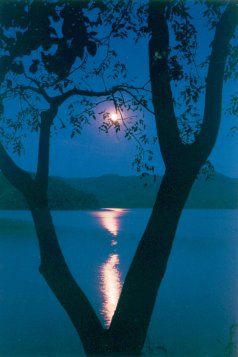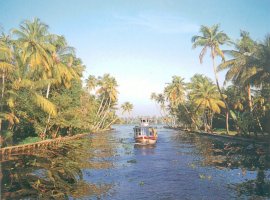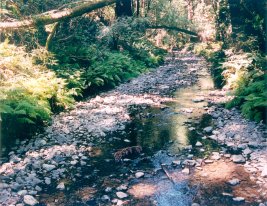|
|
 |
 |
  |
 |
|
|
|

|
| |
|
|
|
| |
|
An
Approach To Environment, Ecology & Wildlife |
| |
|
|
|
| |
|
|
|
The
media often reports that all over the industrialized |
 |
|
world,
the environmental movement is facing a backlash. |
| |
Major
environmental organizations like Greenpeace and |
| |
the
Sierra Club report that fewer people are joining them |
| |
now.
It is as if people have had their fill of protesting |
| |
against
the latest form of environmental degradation |
| |
and
are looking for some positive developments instead. |
| |
In
the US in particular, with the economy prospering at |
| |
the
moment, the sentiment is in favour of boosting |
| |
further
growth to protect jobs, if not to create them. |
| |
|
| |
In
India too, the media, all too anxious to take its cue |
| |
from
the West, has adopted a somewhat similar attitude |
| |
towards
the environment. It would be hard to find a |
| |
single
environment correspondent in any newspaper, as |
| |
there
was a couple of decades ago. In the ’80’s and the |
| |
’90’s,
especially after the Earth Summit in Rio in 1992, |
| |
the
environment became a political issue with treaties |
| |
being
placed on the international agenda, and the media |
| |
covered
these issues in detail. Now the media believes it |
| |
is
taking a “pragmatic” position on the environment and |
| |
is
not bending over backwards to be green. |
|
| |
|
| |
|
| |
|
|
|
home |
|
|
| prologue |
|
|
| welcome |
|
|
|
contents |
|
|
| subject
moderators |
|
|
|
history |
|
|
| sexuality |
|
|
| social
landscapes |
|
|
| art |
|
|
|
dance |
|
|
| literature
|
|
|
| music |
|
|
| cinema |
|
|
| environment
|
|
|
|
economics |
|
|
|
pot pourri |
|
|
| feedback |
|
|
| |
|
|
|
|
| |
|
|
However,
in both North and South, the media appears to be somewhat off the mark.
Although |
 |
|
|
there
may not be the same fervor on the part of the public to take part in demonstrations,
there |
| |
|
is no doubt that they feel strongly about protecting the environment. The
best proof of this are |
| |
|
the regular global surveys conducted by a opinion poll agency in Canada,
which monitors public |
| |
|
perceptions on environmental issues throughout the world. Repeatedly, environment
figures |
| |
|
among the top five, and often three, concerns globally, irrespectiveof the
economic status of |
| |
|
the country. |
| |
|
|
|
| |
|
|
| How does one
reconcile this with the media perception? |
|
|
| All too often,
both politicians and the media are not in |
|
 |
| touch with what
really concerns people. There is no |
|
| question that
increasingly, people everywhere are not |
|
| action too.
Even in a
city like Mumbai, which
is poised |
|
| to become
the most populous in
the world by 2020, |
|
| citizens in
many localities are banding
together to |
|
| protect their
mangroves from being destroyed,
|
|
| clearing their
garbage and the like. A slogan in this |
|
| metropolis
is: “If the mangroves go, man goes too!” |
|
|
| |
|
|
|
| |
|
|
| |
|
|
| |
|
|
| |
|
|
| |
|
|
| |
|
|
| |
|
|
| |
|
|
| |
|
|
| |
|
|
| |
|
|
Children
in particular have got the message and far more sensitive to their environment
than |
| |
|
|
their
parents. This column will look at various aspects of India's environment,
including its |
| |
|
|
dwindling
wildlife, and keep you abreast of developments in this country. |
| |
|
|
|
| |
|
|
EXHUMING
THE GHOSTS OF SILENT VALLEY |
| |
|
|
|
| |
|
|
|
|
 |
| Some 16 years ago,
this columnist wrote a book titled |
|
| Temples or Tombs: Industry
versus Environment, |
|
| Three Controversies,
which was published by the |
|
| Centre for Science
& Environment in New Delhi. |
|
| By far the most interesting
of the three case studies |
|
| was the Silent Valley
hydroelectric project in Kerala, |
|
| largely because of
the high level of consciousness |
|
| among the people in
the state. I had, at the time, |
|
| surveyed similar controversies
around the world, which |
|
| typically revolve around
the claims of the project |
|
| authorities, who exaggerate
the benefits that such |
|
| so-called development
schemes generate, versus those |
|
| of the greens who want
to preserve sites. Nowhere else |
|
| had a project stirred
such strong sentiments on both |
|
| sides. The title of
my book was derived from Pandit |
|
| Nehru's oft-quoted
remark about such projects being |
|
| “the temples of today”. |
|
|
| |
|
|
| |
|
|
| |
|
|
| |
|
|
| |
|
|
| |
|
|
| |
|
|
| |
|
|
 |
|
|
| |
|
| |
|
| |
|
| |
|
| |
|
|
| |
|
|
| |
|
|
| |
|
|
| |
|
|
|
|
| |
|
|
The
Kerala government's recent announcement that it was exploring the possibility
of re-opening |
| |
|
|
the
Silent Valley will exhume ghosts that most thought had long been interred.
The scheme to
dam |
| |
|
|
the
Kunthipuzha river and generate 120 megawatts of power had raised a
fierce debate in the late |
| |
|
|
1970’s
and is probably the first test case in the country of the supposed
conflict between the needs |
| |
|
|
of
development and environment. Thanks mainly to Mrs
Indira Gandhi, the issue was
resolved in |
| |
|
|
favor
of the environmentalists, who wanted to preserve this rain forest in the
western ghats. |
| |
|
|
|
|
| |
|
|
 |
|
Kerala,
till today, presents a classic paradox in that |
| |
it
is, in terms of human resource development, the |
| |
leading
state in the country with near-total literacy |
| |
and
very low infant mortality and other indices. |
| |
However,
when it comes to economic development |
| |
or,
more particularly, industrial growth, its record |
| |
has
been abysmal. Due partly to its rampant |
| |
unionis
mand high wage rates, entrepreneurs
have |
| |
thought
thrice before investing in the state. The |
| |
result
has been widespread unemployment,
with all |
| |
the
disaffection that this generates. When the
Silent |
| |
|
Valley
project was proposed in the 1970s, the |
 |
|
proponents
argued that Kerala lacked industry at |
| |
least
partly because it was short of power. Because |
| |
the
state was heavily influenced by Marxist doctrine |
| |
it
was, after all, the first to elect a
communist party |
| |
to
power by the ballot in the world, as far back as in |
| |
1957
the politicos quoted
Lenin who famously |
| |
declared that soviets (collectivised
farms) plus |
| |
electrification
equalled communism! They argued, |
| |
further,
that this was a renewable source of power, |
| |
unlike
nuclear or thermal energy, and the river was |
| |
otherwise
flowing “wastefully” to the Arabian Sea. |
|
| |
|
|
| |
|
|
| |
|
|
| |
|
|
| |
|
|
| |
|
|
| |
|
|
| |
|
|
 |
|
|
| |
|
| |
|
| |
|
| |
|
| |
|
| |
|
| |
|
| |
|
|
| |
|
|
| |
|
|
| |
|
|
| |
|
|
| |
|
|
| |
|
|
|
|
| |
|
|
It
was a group of science teachers and other progressive professionals who
had banded together |
| |
|
|
under
the banner of the Kerala Sastra Sahitya Parishat (KSSP) who decided to take
a close look at |
| |
|
|
the
pros and cons of the project. As the name of the organisation suggests,
it first translated |
| |
|
|
scientific
books into Malayalam but then began engaging in debates about environment
and |
| |
|
|
development.
Today the KSSP is one of the foremost environmental groups in the world,
with |
| |
|
|
over 50,000 members. |
| |
|
|
|
| |
|
|
The
KSSP correctly assessed that the economic and ecological value of preserving
this unique strip |
 |
|
|
of
forest, which was uninhabited even by tribals, outweighed the benefits of
the power that it |
| |
|
would
produce. It possessed many types of wild flora and fauna, including a
very rare primate, |
| |
|
the
lion-tailed macaque, the loss of which would deprive Kerala of its biodiversity.
As can well be |
| |
|
imagined,
many of the arguments in favor of such preservation, which
have today become |
| |
|
commonplace,
were difficult to defend three decades ago. |
| |
|
|
|
| |
|
Pointedly,
the Kerala State Electricity Board asked: |
| |
|
“Are
monkeys more important than men?” |
| |
|
|
|
|
| |
|
|
Ultimately,
Mrs. Gandhi was persuaded more by the opinion of global environmental organizations |
| |
|
|
like
the World Wildlife Fund and the International Union for Conservation of
Nature to call off the |
| |
|
|
project.
She was always more susceptible to pressure from abroad than
from within the country, |
| |
|
|
which
is why, for instance, she decided to hold elections to legitimize
her authoritarian rule during |
| |
|
|
the
emergency in 1977. When she returned to power
in 1980, she instituted a committee under |
| |
|
|
Prof
M.G.K. Menon, which ruled against the
project and she went along with it. Subsequently, Silent |
| |
|
|
Valley
was declared a national park, which is its status till today. |
 |
|
|
|
|
| |
|
This
legal position cannot be easily changed. As witnessed in state after state,
attempts by politicians |
| |
|
and
industrialists to dereserve national parks have not been favourably received
by courts. How the |
| |
|
Kerala
government ever hoped to get around this reservation is a matter of considerable
speculation. |
| |
|
According
to newspaper reports, the Union Environment Ministry had issued a directive,
suggesting |
| |
|
that the state government obtain clearance from the Indian Board of Wildlife,
as well as the Supreme |
| |
|
Court.
The former is bound to put its foot down, for Silent Valley is one of the
last vestiges of what is |
| |
|
known as shola forest the unique ecosystem sheltered in the folds of the
western ghats. |
| |
|
|
|
|
| |
|
|
|
| |
|
|
| |
|
|
| |
|
|
| |
|
|
| |
|
|
| |
|
|
| |
|
|
| |
|
|
| |
|
|
|
| |
|
|
Since these areas of the
western ghats are internationally recognised as one of the “hot spots”
for |
| |
|
|
biodiversity in the globe,
Silent Valley is in far greater need of protection than the
temperate zones |
| |
|
|
of the Himalayas in north
India. It is also understood that the Kerala forest
department itself will |
| |
|
|
oppose the project. For
all these reasons, the State Electricity Minister,
K. Sivadasan, who had earlier |
| |
|
|
dismissed environmentalists'
fears as “imaginary”, to be backtracking on the move. |
| |
|
|
|
| |
|
|
It is strange that the many politicians
and bureaucrats have failed to learn the lessons of history.
The |
 |
|
|
Silent
Valley issue raised a fierce controversy, not only in Kerala but elsewhere
in the country notably |
| |
|
in
Mumbai and Delhi and internationally. As the Menon committee report
pointed out, it was better
to |
| |
|
err
on the side of caution and prevent some of the country's
most valuable natural heritage
from being |
| |
|
lost
to future generations. What is more,
if there was an economic cost to be
put to such preservation, |
| |
|
it
was the presence of priceless
plants such as the wild varieties of rice
available in the area (and
in |
| |
|
the
forests of Sri Lanka). These
contain genes which can resist pests which attack new high-yielding |
| |
|
varieties
of rice, and are therefore like a natural storehouse whose economic benefit
is simply |
| |
|
incalculable. |
| |
|
|
|
| |
|
No
one can deny that Kerala needs power, but there are several alternatives
which need to be explored. |
| |
|
Unfortunately,
the state government, which has perhaps never recovered from the
slight at the hands |
| |
|
|
of
the Centre in preventing it from exploiting what it believes are its own
natural resources, has been |
| |
|
|
turning
to other ill-conceived energy schemes. These include
another hydroelectric project
in a western |
| |
|
|
ghats
forest, an offshore thermal plant and
even a nuclear station in one
of the most densely populated |
| |
|
|
states
in the country. Instead, it
could consider small run of the
river hydel units along its 43
rivers, |
| |
|
|
which
would generate sufficient power for small agro-industrial units that are
in any case the mainstay |
| |
|
|
of
Kerala's economy. |
| |
|
|
|
|
| |
|
|
| In
the final analysis, the attempt to resuscitate |
|
|
| the
long-buried Silent Valley project raises, as it |
|
| did
three decades ago, vital questions concerning |
|
| the
development paradigm which the state intends |
|
| to
adopt. If big industry has been deterred from |
|
| entering
the state for reasons already stated, the |
|
| government
ought to consider how to promote a |
|
| more
localised form of development where the |
|
| abundant
natural resources are exploited in a |
|
| more
ecologically sensitive manner. |
|
|
| |
|
|
| |
|
|
| |
|
|
| |
|
|
| |
|
|
| |
|
|
| |
|
|
| |
|
|
 |
|
|
| |
|
|
|
| |
|
Love, |
| |
|
Darryl |
| |
|
|
|
TOP |
| |
|
|
|
|
| |
|
|
|
|
![]()
![]()
![]()

![]()














